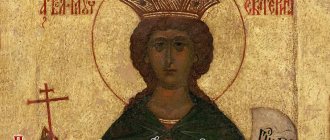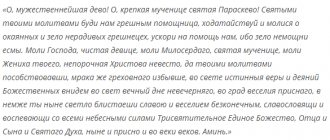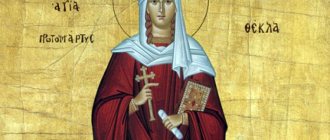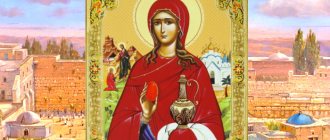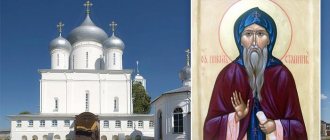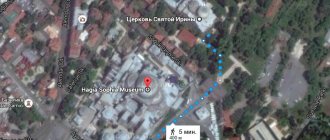Marry by order
Love is not a feeling, but a choice. Now many books and articles have been written about this, but Saint Monica had to discover this truth on her own: she was married off without even asking her opinion. IV century - that’s how it was accepted then.
And the problem was not that the girl did not meet her future husband before the wedding, but that he was not a Christian. Or, as they would say now, he was an unbeliever. That is, she was forced to live with a person of a different worldview, who looked at everything that is important for a person in life in a completely different way.
Lovers are not those who look at each other, but those who look in the same direction. The author of this aphorism is unknown, but one thing is certain - Monica was completely deprived of this joy. Nevertheless, “...she calmly endured his infidelities,” recalls Augustine, “she and her husband never had any quarrels about this.”
Such circumstances could cause stress and unbearable suffering for many. Monica thought differently. Living with an unbelieving husband is not a problem, but a task, and Scripture has recipes for solving it. “You also, wives, be subject to your husbands, so that those of them who do not obey the word may be won without a word by the lives of their wives when they see your pure, God-fearing lives,” teaches the holy Apostle Peter. That's exactly what Monica did. She never contradicted him, knowing his hot temper. “She served him as a master and tried to win him for God,” writes St. Augustine. In the end, she won. The patrician was baptized. But between these two events - the wedding and the baptism of the husband - lay many years of marriage, the birth of three children, countless infidelities of the husband and the same countless prayers of the wife for him.
In Monica's case, the task of converting her husband to faith was complicated by at least two circumstances. The husband did not see any problem in the fact that he “went to the left.” And, apparently, he didn’t even hide them, since his son talks about “betrayal.” To become a Christian, he had to be convinced that such behavior was treason and should be abandoned once and for all. But the most difficult thing is that Monica herself needed to find the strength to forgive her wandering husband. She succeeded in both.
The only source of information about the life of Saint Monica is the memoirs of her son Augustine. He does not give detailed descriptions of how she brought her husband to faith. But we can highlight several rules for the life of a saint that give some idea about this:
- never reproach your husband for his shortcomings, no matter how terrible they may seem
- sincerely obey him, considering herself his servant
- under no circumstances reproach him for anything, even if it seems quite fair
- always pray for him
It doesn't look like Monica is happy in her family life. In fact, a significant part of the years allotted to her (and she lived for 56 years) were stressful situations and mental trauma. It's not just that the husband cheated. Most likely, he raised his voice to his wife more than once. He had someone to follow by example. In other families with which Monica and Patricius maintained relationships, husbands even beat their wives, and no one considered this a particular tragedy. At least, Augustine remembers that his mother’s girlfriends walked around with bruises. But Patricius did not raise his hand against Monica, although, as his son recalls, he was a very hot-tempered person. Now they would say that the saint had emotional competence - she knew the feelings of her loved ones, her own, and knew how to use this knowledge for the benefit of the whole family.
A separate story is Monica’s communication with her friends. Women often complain to their friends about their lives, including about other friends. Monica listened patiently to their complaints, but never supported their grumbling or judgment. “My mother told each friend what contributed to the reconciliation of both.”
If Monica lived today, she would fill the halls for trainings on personal growth and the art of communication. Faced with a huge number of stressful situations, she calmly resolved all these situations, skillfully ending each conflict with peace. But her main victory is saving her son.
Sandro Botticelli. Saint Augustine the Blessed in prayerful contemplation. Fresco. OK. 1480
Blessed Monica. Mother of Blessed Augustine.
Express delivery
Courier delivery in Moscow Delivery time: within the Moscow Ring Road – 2–4 working days Delivery cost: within the Moscow Ring Road – free
Pickup from the Pokrov online store
Delivery time: 1–2 business days. You can check the possibility of order completion “day to day” by calling the online store.
Postal delivery in Russia
Orders are processed Monday through Thursday and shipped on Fridays. Orders up to 2 kg are sent by valuable parcel post; Orders weighing from 2 kg to 10 kg are sent by valuable parcel. Postal delivery of orders is carried out only subject to 100% prepayment, including postage. The final order amount is sent by email or phone. Delivery by mail within Russia, as a rule, takes 2-3 weeks, but its actual period depends on the distance. The cost of delivery of parcels and parcels is calculated in accordance with the tariffs of Russian Post. The cost of delivery by Russian Post consists of: postal tariff, determined depending on weight and distance; the cost of the packaging itself, and postal services for packaging,
Expedited mail
Delivery time is on average 3-4 days. Delivery costs are calculated in accordance with the current service tariffs. Our manager will inform you of the exact delivery cost by phone or email.
Delivery by transport companies
Our store uses the services of freight forwarding companies to deliver orders throughout Russia and the CIS countries. Delivery times and costs depend on the tariffs of the selected transport company.
Cash
Cash payment only for pickup.
Bank transfer
Payment by bank transfers according to the issued invoice. An invoice for payment is sent by email after checking the availability of goods in the warehouse. When making a money transfer, the bank charges a commission of 1 to 3% (the commission percentage is indicated approximately and depends on the conditions of the specific sender’s bank). To send an order, please provide the payment document number, full name of the sender, as well as the date, amount and order number. Delivery of goods is carried out after receipt of payment information.
Money transfers
Payment through electronic payment systems Details for transferring funds are sent by email after checking the availability of goods in the warehouse. When making a money transfer, the operator charges a commission of 1 to 3% (the commission percentage is indicated approximately and depends on the conditions of the specific money transfer system). To send an order, please provide the payment document number, full name of the sender, as well as the date, amount and order number or other data necessary to accept the transfer. Delivery of goods is made after receipt of funds.
Mother's Prayer
Patricia and Monica had three children - two boys and a girl. The eldest's name was Augustine. The boy grew up and began to lead a far from pious life. He lived with his girlfriend, as they would say now, in a “civil marriage.” They had a child. Further - worse. Augustine fell into the Manichean sect, and, being carried away by their teaching, managed to lure his friends into this organization.
What could Monica do in such a situation? Urge your son to improve, order prayer services? She had two simple methods: she prayed herself and asked priests she knew to convince her son of the truth of Christianity. One of the priests answered her: “the son of such tears cannot die.” In other words: you cry so much for him that he will definitely become a Christian. “In conversations with me, she often recalled that she accepted these words as if they had come to her from heaven,” writes Augustine.
How did Saint Monica pray? Did you order magpie in seven churches? Have you read the akathists? No, of course, all this did not exist in her time. But one thing we know for sure is that Augustine was in the sect for 10 long years. All this time, the mother did not lose hope. And, in the end, Augustine became an Orthodox Christian. His mother died in the year of his baptism. She was then 56 years old, her son was 33 years old.
At first glance, this is not the strongest result of missionary work: in 10 years there was only one convert. But let's remember who this man became - one of the greatest saints of the Christian Church, equally revered by both Orthodox and Catholics. His Confession still remains one of the most powerful Christian books. In it, among other things, there are the following words: “Yes, if I am Your worthy son, Lord, it is because You have given me Your faithful servant as a mother.”
Reverence
Tomb of Saint Monica, Basilica of Sant'Agostino, Rome
Saint Monica was buried in Ostia and at first seems almost forgotten, although her body was moved in the 6th century to a hidden crypt in the Church of Santa Aurea in Ostia. Monica was buried near the grave of St. Ourea Ostia.[7] Her tomb was later moved to the Basilica of Sant'Agostino, Rome.
Anicius Auchenius Bassus wrote a funerary epitaph for Monica, preserved in ancient manuscripts.[7] The real stone on which this was written was rediscovered in the summer of 1945 in the Church of Santa Aurea. The fragment was discovered after two boys were digging a hole to plant a football post in a yard near Santa Aurea.[8]
The translation from the Latin, by Douglas Boin, reads:
Here the most virtuous mother of a young man lit her ashes, a second light to your merits, Augustine. As a priest, serving the heavenly laws of the world, you taught [or are teaching] the people entrusted to you by your character. Glory above praise for your achievements crowns you both - the Mother of virtues, more fortunate for her offspring.[7]
However, in the 13th century the cult of Saint Monica began to spread, and on May 4 a feast was held in her honor. In 1430, Pope Martin V ordered the relics to be transferred to Rome. It is said that many miracles happened along the way and the cult of Saint Monica was definitely established. Later, the Archbishop of Rouen, Guillaume d'Estouteville, built a church in Rome in honor of St. Augustine, the Basilica of Sant'Agostino, and placed the relics of St. Monica in the chapel to the left of the high altar. The Office of St. Monica, however, does not seem to have found a place in the Roman Breviary until the 19th century.
In 1934, the order "Zusters Augustinessen van Sint-Monica" was founded in the Dutch city of Utrecht, which was engaged in social work, offering shelter to women with unwanted pregnancies or women who were victims of domestic violence or abuse. The sisters also opened a number of primary schools. At its height, the order had six monasteries in Amsterdam, Utrecht, Sittard, Maastricht, Hilversum and Arnouville on the outskirts of Paris. Since the monastery of Hilversum, the City of God, was closed in 2014, only Utrecht remains a rest home for the elderly among the sisters and Casella, a secluded wooded area near Hilversum where young people are still welcome for a meditative stay.
Saint Monica statue in Santa Monica, California
The city of Santa Monica, California is named after Monica. Legend has it that in the 18th century Father Juan Crespi named the local spring Las Lagrimas de Santa Monica
("Tears of St. Monica") (today known as Serra Springs), which was reminiscent of the tears St. Monica shed over her son's early wickedness.[9]
However, as recorded in his diary, Crespi named the place San Gregorio
.[9] What is known for certain is that by the 1820s the name Santa Monica was in use, with its first official mention occurring in 1827 in the form of a permit for grazing.[9] In Santa Monica's Palisades Park there is a statue of this saint created by a sculptor. Eugene Morahan; it was completed in 1934.[10]
Bibliography
- Volker Scheer and Corinne Schleif, Opening of the Goose Book: Feast of St. Monica, 2022 [1]
- Peter Brown, Augustine of Hippo: a biography: new edition with epilogue
, Berkeley, University of California Press, 2000 - Everett Ferguson, Encyclopedia of Early Christianity
, Taylor and Francis, 1998, p. 776 - John J. O'Meara, Young Augustine: The Growth of St. Augustine's Mind to His Conversion
, London, Longmans, Green and Co., 1954.
Recommendations
- "...Augustina's mother's name, Monica, is a Berber...the names Monnika and Nonnika appear on tombstones in Libyan, so Monnika is the only Berber name commonly used in English," Michael Brett and Elizabeth Fentress, Berbers
, Wiley-Blackwell, 1997 , pp. 71, 293 - Liturgy of the Hours, Volume IV. Cathedral of Saints, August 27.
- Michael Brett and Elizabeth Fentress, The Berbers
, Wiley-Blackwell, 1997, p.71. - Power, Kim (1999) "Family, Relatives", pp. 353–54 in Augustine Through the Ages: An Encyclopedia
. Allan D. Fitzgerald (ed.). Grand Rapids: Wm. B. Eerdmans, ISBN 978-0-8028-3843-8. - ^ a b c
Media, Franciscan (August 27, 2016).
"Saint Monica" Franciscan Media
. Received 2020-06-26. - Confessions 6.2.2
- ^ a b c
"Church of Sant'Aurea". Ostia-Antica.org. Retrieved March 15, 2011. - Peter Brown, Augustine of Hippo: A Biography, revised edition with new epilogue
(University of California Press, 2000), 124. - ^ a b c
Paula A. Scott,
Santa Monica: A History on the Edge.
Creation of a series from America (Arcadia Publishing House, 2004), 17-18. - "Santa Monica Sculpture". Are you here. Com. n.d. Retrieved March 14, 2011.
- Patricia McGerr (1964), My Brothers, Remember Monica: A Novel of Augustine's Mother
, New York: P. J. Kennedy. - Smither, Howard E. (1977-01-01). History of the oratorio
. UNC Press Books. ISBN 978-0-8078-1274-7. - Bidart, Frank (1983). Paris review. https://www.theparisreview.org/poetry/3046/confessional-frank-bidart
external reference
| Wikimedia Commons has media related to Saint Monica of Hippopotamus . |
- Gerbermann, Charles, ed. (1913). "Saint Monica" Catholic Encyclopedia
. New York: Robert Appleton Company. - Saint Monica at EWTN
- Saint Monica in Sacred Texts
| Portals Access related topics |
|
| Authoritative control |
|
